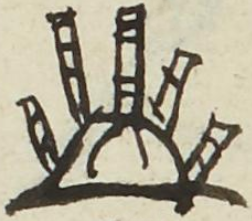Acatepehua (MH672v)
This black-line drawing of the compound glyph for the personal name or place of origin, Acatepehua (perhaps “Possessor of Reeded-Mountain”) is attested here as pertaining to a man. The glyph shows a frontal view of a hill or mountain (tepetl) as a naturalistic sketch. It has two curving lines coming down the front that attempt to give it some three dimensionality. Five vertical, segmented reeds (acatl) stand along the top edge of the hill. These are squared off at their tops. If this is not literally about a mountain, the ending (-tepehua) could refer to some type of defeat, and the compound could be partially phonetic.
Stephanie Wood
This is a place name in what is now the state of Chiapas. An archaeological site called Acatepehua is also known for having an archaic shell midden.
Stephanie Wood
luys . acatepeua
Luis Acatepehua
Stephanie Wood
1560
Jeff Haskett-Wood
cañas, montañas, cerros, nombres de hombres

aca(tl), reed or cane, https://nahuatl.wired-humanities.org/content/acatl
tepe(tl), hill or mountain, https://nahuatl.wired-humanities.org/content/tepetl
-hua (possessive suffix), has, https://nahuatl.wired-humanities.org/content/hua
tepehua, to throw down, defeat or conquer, https://nahuatl.wired-humanities.org/content/tepehua
Poseedor de la Montaña de Cañas
Stephanie Wood
Matrícula de Huexotzinco, folio 672v, World Digital Library, https://www.loc.gov/resource/gdcwdl.wdl_15282/?sp=425&st=image.
This manuscript is hosted by the Library of Congress and the World Digital Library; used here with the Creative Commons, “Attribution-NonCommercial-ShareAlike 3.0 License” (CC-BY-NC-SAq 3.0).




